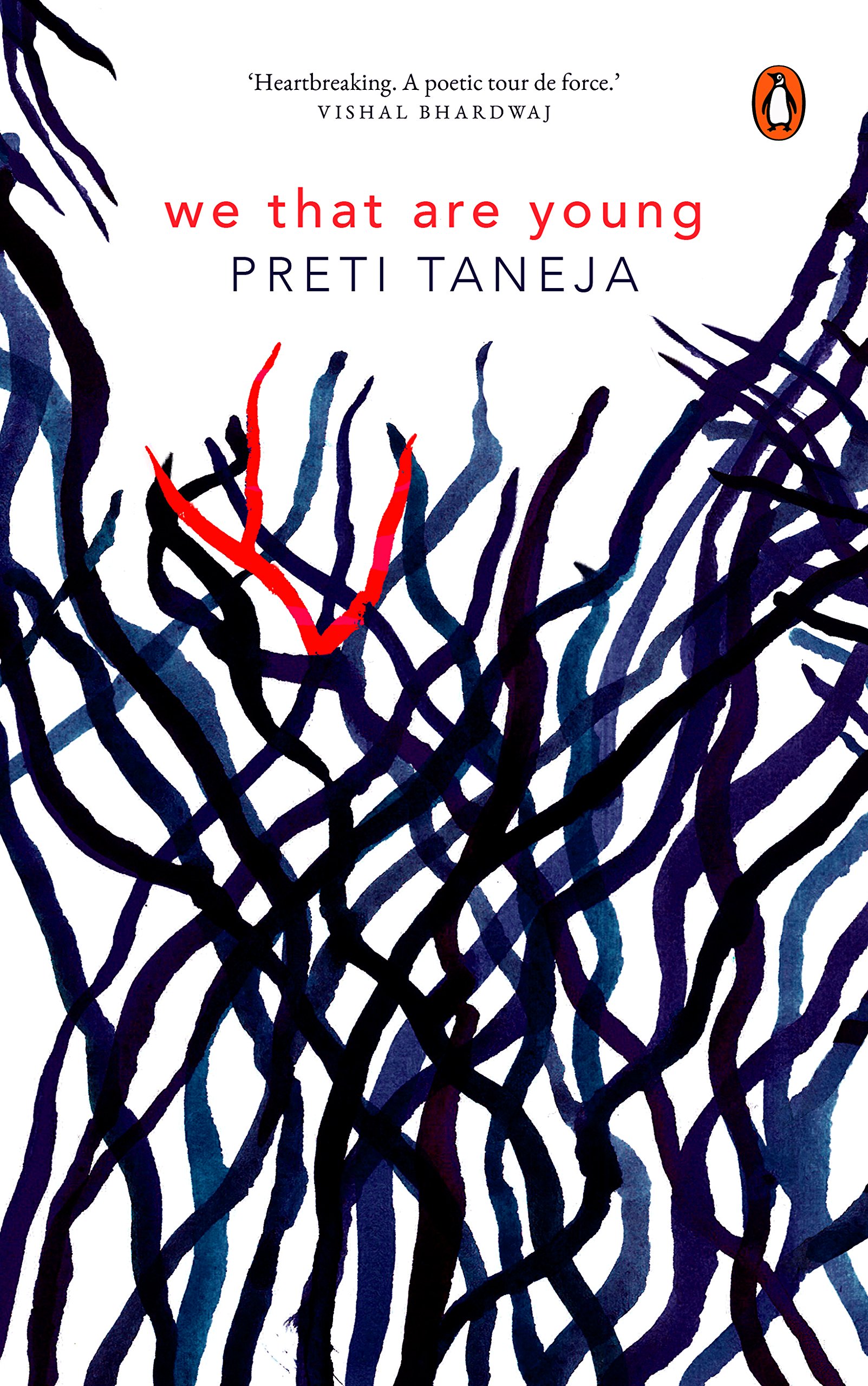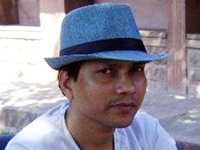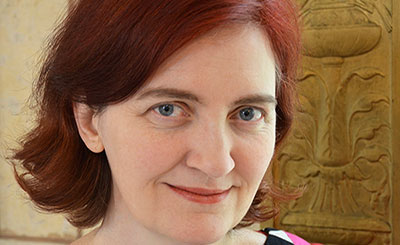
Preti Taneja. Photo: Rory O’Bryen
In We That Are Young, Preti Taneja ‘translates’ the language and form of Shakespeare’s King Lear to explore the messy connections between the past and present, England and India
In her debut novel, We That Are Young, UK-based author, academic and human rights activist Preti Taneja dwells on Shakespeare’s King Lear to tell the story of the darkness of our world. A commentary on contemporary India, the novel is the story of a country that, like the old king, is descending into madness. Jivan Singh, bastard son, returns to Delhi after fifteen years of exile to find a city on fire with protests and in the grip of drought. On the same day, Devraj, father of Jivan’s childhood playmates, founder of India’s most important company, announces his retirement, demanding daughterly love in exchange for shares. Sita, his youngest child, refuses to play, turning her back on the marriage he has arranged. Her sisters Gargi and Radha must take over the Company and cement their father’s legacy. As they struggle to make their names, a family and an empire begin to unravel, careening from Delhi mansions to luxury hotels, from city slums to the streets of Kashmir, from palace to wayside.
Taneja was born in England to Indian parents and spent most of her childhood holidays in New Delhi. She has worked as a human rights reporter and filmmaker in Iraq, Jordan, Rwanda, and Kosovo. A fellow at Warwick University, her 2014 novella, Kumkum Malhotra, won the Gatehouse Press New Fictions Prize. She is also the editor of Visual Verse and was selected as an AHRC/BBC Radio 3 New Generation Thinker for 2014. We That Are Young, Taneja says, is a “translation” — of language and form — of Shakespeare’s King Lear, to explore the messy connections between the past and present, England and India — “to try to see our world and its darkness with clear eyes”. Excerpts from an interview:
Nawaid Anjum: In We That Are Young, your homage to Shakespeare’s King Lear, you delve into the inner worlds of the contemporary corporate India. In many ways, the corporate India of today — with its insidious entrails of patriarchy, misogyny, blind adherence to tradition and corruption — provides for a perfect setting for such a retelling. How conscious were you of such parallels when you set out to work on this novel?
Preti Taneja: We That Are Young wasn’t written to pay tribute to, or affirm Shakespeare’s ‘genius’ so it’s not homage as such. If I had to say what it is — I’d call it translation — of language and form — to get into the messy connections between the past and present, England and India — to try to see our world and its darkness with clear eyes. Strictly speaking, it is political appropriation — I was very aware of the thematic parallels between the play and the Indian setting and, because Shakespeare’s works were a key tool in the British Empire’s ‘civilising’ arsenal, used King Lear as a way of interrogating the violent and traumatic legacies of colonialism in the country of my parents’ birth by the country of mine. It also gave me the chance to explore some of the inequalities that exist in the India I wanted to write about — which stem from what gets justified as ‘tradition’, ‘values’ ‘our culture’ and so on, but is just subjugation of women and ‘others’ to support the dominant status quo.

Nawaid Anjum: A retelling of such a nature, especially one with India as its setting, is a feat in itself, considering it’s a country with its own set of complexities and contradictions. Tell us about the process of distilling the realities of the country — with bewildering diversity — in the novel.
Preti Taneja: I spent a lot of time in India, and a lot of time reading it, as I was growing up. In 2012, I researched the book, listening and observing people from all walks of life in Delhi, Goa, Amritsar and Kashmir — the real places where the story is set. I had some extraordinary experiences, including attending luxury car shows in Delhi and tasting wazwan being cooked in the hidden courtyards of Srinagar, over box fires. Those scenes didn’t make it into the book, but they all became part of the world I was creating. I’ve attended Jantar Mantar protests with women from disadvantaged backgrounds; I’ve spent time with mothers in Delhi slums whose children have died in orphanages while they were trying to earn enough to eat each day. I’ve heard boasts from leading businessmen about all they have and what they do to maintain their wealth — things that seem too fantastic for ‘serious’ fiction — but which happen, and have serious ramifications for thousands of lives. I found that everyone, no matter their background, was eager to explain things to me about India, everyone loves telling their own story and giving their opinions. The most important part of my research was listening, then writing, and rewriting and rewriting …
Nawaid Anjum: You tell the story in five sections, with each section having a separate narrator and standing out for their distinct style, language and tropes. Tell us about the final structure of the novel, the process of whittling down to five main sections and the decision for each of them to have a voice of their own.
Preti Taneja: The first line of the novel, ‘It’s not about land, it’s about money’ was in my head for a long time. It came as a response to Jane Smiley’s focus on land in A Thousand Acres which re-visions the Lear story in a family-owned farm in 1980s Iowa, America. At the end of that novel, the farm is sold to the ironically named ‘Heartland Corporation.’ My opening makes Smiley’s ending, her predicted future, explicit. I am paying homage to her realist work — while moving into new formal territory. My first line gave me the idea for the title of the book, and the title inspired the structure. The five characters are based on the five young people in Shakespeare’s play and the epigraph of the Kabir poem, with its ‘family of five’ brought Shakespeare as synecdoche for England, and old India together. The different voices are a key part of the ethics of the book and its attempt to represent the disconnection humans live with, and the difficulty of trying to decide on truth based on subjective experiences.
Nawaid Anjum: Talking of the structure, it is also of interest to see how you have conceived the opening section and the final sixth section, called ‘We That Are Young’. The opening section, told from the point of view of Jivan, the son of Ranjit, who is the right hand man of Devraj Bapuji, the Lear figure. Having been sent to America with his mother, he is returning for the first time, reconnecting with the old life he has barely been in touch for the past 15 years. This marks his attempt to reclaim his place in the company. How did you conceive of the opening section? How crucial was this return to the story?
Preti Taneja: Beginning with Jivan’s return was very important. His limited idea of India, the expectation that he will return as conquering hero, more modern than those he left, is a way of critiquing the nostalgic, patronising idea of a ‘teeming’ India full of ‘colour’ and smells and noise and so on, where funny little brown men are only too happy to serve and ‘exotic’ women keep their almond-shaped eyes cast low. I grew up seeing that India in the mainstream British media, and it appears in books — including by elite Indian and diaspora writers working in English in the late 20th Century. In no way does that match my experience of the place. Jivan sees poverty — but he’s comforted by it because it makes him feel culturally superior. Those sterotypical scenes of cows in the road and so on, which he registers as if watching sepia film through the tinted windows of the car, are present in the novel to deconstruct Empire nostalgia and those racist tropes. Meanwhile, Jivan has struggled to be accepted as more than a second class citizen in America, because of the colour of his skin — so, though he knows he’s still perceived as an outsider in both places, he’d rather claim some of the wealth and prosperity he can see in India: he wants his skin to fit, and he wants to find a sense of family again even while he retains his sense that America is better to compete with his Indian peers for power.
Nawaid Anjum: Also, tell us about the final section. It is a section that restores the reader’s sense of objectivity after the alternative takes on Devraj and his legacy narrated by Gargi, Radha, Jeet and Sita. What did you want to achieve in the final section?
Preti Taneja: We That Are Young’s conceptual underpinnings lie to an extent in the work of the Russian philosopher Mikhail Bakhtin, whose work on language, intertextuality, concepts of the self and how they can be expressed in the novel form, and space and time as represented in literature influenced my formal decisions about structure, voice and perspective. We That Are Young is not realist fiction, nor was it ever meant to be. That kind of fiction is predicated on a Judeo-Christian linear understanding of time and mortality inappropriate to the India of the book. With the marriage of the epic tragedy of Lear and the Hindu epic tales – as well as its form and time structure, the clues are all there to understand the book as dystopian fairytale – the best of which are rooted in a world we intimately know. I didn’t want the book to answer all questions, tie up all loose ends and absolve a reader’s ethical mind from engaging in the problems of the world beyond entertainment. Instead it works with a grotesque realism, a carnivalesque that employs many voices and linguistic and cultural registers to show the impossibility of ‘knowing’ any kind of fixed truth. That’s what I wanted for the final section, and in an earlier draft I actually had merged the voices far more, depending on their difference from each other being clear enough so that the reader would follow whose point of view it was. But in the final edit, that proved unworkable — the main idea was to get those different characters speaking in proximity on the page so readers could hear and see the tonal shifts having been immersed in each section. Readers will encounter English, movie-style and modern Hindi, Hinglish, there is Sanskrit, there is Urdu, there is Napurthali. Which of course, is made up — Napurthala, and the slum Dhimbala don’t exist — Napurthala is an imagined ‘state’ whose fairytale existence undercuts any claim to straight realism that readers might think the book makes. Dhimbala is the nine circles of hell. For it to work there must be truth in the emotional currents and relationships, there must be recognisable notes. The places and people in We That Are Young are symbolic — their purpose is subversive, and they must speak across cultures. What the book describes is extreme but so real, and so possible in the USA, in India – in so many places. We can do so much more if we trust ourselves as hybrid writers and readers than when we get stuck trying to define work into constructed literary categories. If we can avoid that, then things get really exciting.
Nawaid Anjum: How does your academic and advocacy and human rights work inform your writing, especially in this novel? Did you want this novel to present a critique of today’s consumerist culture and, at the same time, wanted to make a fervent appeal to those who will inherit this world and its culture to be more attuned to its depravities?
Preti Taneja: Everything I’ve done to date — from research and advocacy with Iraqi refugees in Jordan and Sweden or in refugee camps, to the time I spent researching creative and critical responses to King Lear as part of my PhD, has informed the book somehow. It might manifest in a scene description, an idea of character or a line — certainly I would not have set the Jeet section, which takes place in the basti, if I hadn’t worked extensively in such places, alongside people living with extreme dignity, in extreme poverty, or disenfranchised by conflict. In answer to the second and third parts of your questions — yes, and yes — but also to be attuned to what we can do about those depravities. It is a hopeful book, after all – the hope lies just beyond the text, in the reader’s hands.
Nawaid Anjum: Out of the three sisters — Gargi, Radha and Sita — were there moments when you, as a writer, felt more empathetic to either one of them, connected more with?
Preti Taneja: There are three ‘types’ women are allowed to be in mainstream cultural narratives (which are based on epics and fairytales): crone, whore and saint. Each sister in the novel critiques and escapes those types even while she’s constricted by society to embody them. And each possessed me in turn as I was writing. Gargi leant me her determination to keep going. Radha was heartbreaking to write, because her trauma is so extreme compared with what the other characters suffer. We all know a Gargi, a Radha and a campaigning Sita, (whose ecofeminism is in line with Cordelia’s acts of resistance as well as her eponymous character in the Ramayana.) But Radha devastated me… if the #metoo campaign had begun when I was writing then (maybe) she could have been saved.
Nawaid Anjum: The novel also blends India’s contemporary narrative with its imperial history. Tell us about the ways the novel reflects on the subcontinent’s continued fetish and ornamentation of its ruling classes and the messy issues of inheritance.
Preti Taneja: One of the aspects of Lear that fits so well with the Indian context is the idea of accession. When Lear gives up his Kingdom, is he still a King? His central question in the play — ‘who is it that can tell me who I am?’ asks us to think about what we ‘value’ in our idea of ourselves. And that accession chimes with what happened in the name of the new India in 1947 — that problem of acceding power is intricately connected to what happened next in Kashmir. What constitutes true nobility goes beyond wealth or status, or bloodlines. We all have it, no matter where we are born. It’s in our actions towards others that it shows (or not).
Nawaid Anjum: In the novel, you have, moving beyond the populist post-colonial writing, drew upon the narrative tradition of, for instance, Ramayana and Mahabharata. How crucial were the parallels with ancient Indian texts?
Preti Taneja: I studied Sanskrit language and the epic texts, including Patanjali’s Yoga Sutras, the Gita and Upanisads for my undergraduate degree in Theology. So I come to those classical texts as a scholar of translation, language and philosophy, including concepts such as dharma, kama and artha. It was brilliant and necessary given the setting to be able to bring that to bear on King Lear — which contains appeals to different ideologies from rational atheism, to belief in fate, fortune’s wheel, pagan gods, and Christian ideas of sacrifice and redemption. Epics offer space for strange permutations of time and place, for mythical story-telling and for thinking about morality — the book brings cultural landscapes into conversation in ways that readers understand because we are always navigating many worlds.
Nawaid Anjum: And, talking of ancient texts, in the novel, there are constant references to some constructs. For instance, Dharma, the idea of a moral quandary that hardly achieves resolution, perhaps as much in the novel as in the ancient Indian texts. Were you interested in exploring this quandary, rooting the story in a certain ambiguity to implicate your characters in each other’s actions?
Preti Taneja: Yes, that’s one of the most important themes of the novel. The Indian texts and ideas, as Gurcharan Das puts it — the problem of ‘how to be good’ — which the Gita explores, is the complementary force to Shakespeare’s tragic vision in We That Are Young. The key prophecy the Fool makes in King Lear, of the way the world could be — with its strange future anterior perspective, found its parallel in a verse from the Gita — ‘Never was a time that I did not exist….’ Lear asks whether each of us gets what we deserve according to our actions. Dharma is the Hindu way of thinking about such questions, but it also has the potential, as a concept to be co-opted by fundamentalists (such as Jeet) to maintain inequality and keep certain people on top of the pile. It had to go into the book.
Nawaid Anjum: The novel also stands out for its exploration of Kashmir, releasing close on the heels of Arundhati Roy’s second novel, The Ministry of Utmost Happiness, which also evokes the place. How crucial was to keep Kashmir at the heart of the trauma of war and forced migration?
Preti Taneja: I’ve always been fascinated by the power play of Partition, horrified by the human cost of it. Dover is where the all the mess that follows the division of Lear’s kingdom converges to be reckoned with, and that was always Kashmir in my mind. The UK education system, which I grew up in, keeps the population ignorant of colonialism and its devastations, and of the real human tragedy the Kashmiri people continue to suffer, while in India the Hindu nationalist narrative overwhelms. I’ve worked in the UN archives on documents pertaining to Partition and to Kashmir and read papers from the 1930s to 1990s that were once highly classified, about it — many from heads of state. Clearly, there are many moments when more could have been done — the political will didn’t exist, though and the blind nationalism of all sides has allowed decades of suffering. I read Basharat Peer’s Curfewed Night when it first came out, and became determined to go to Srinagar myself. The first draft of We That Are Young was finished in 2013 as Vishal Bhardwaj was just beginning work on Haider, (which is also set in Kashmir though it is based on Hamlet.) I had no idea Arundhati Roy was working on a new novel or what its themes would be, until I read it in July 2017 with my hands over my eyes! Thank god I had handed in my own manuscript by then. She has a beautiful mind. The Ministry of Utmost Happiness could not have been written by anyone else.

Preti Taneja. Photo: Louise Haywood-Schiefer
Nawaid Anjum: The novel, in large parts, takes place mostly behind closed doors. What did you set out to achieve through each of these internalised areas? Some reviewers have pointed out that each of these spaces — The Company hotels, The Farm, the slums, Kashmir — all are drawn up from narratives foreign to their histories. Were you conscious of this? If yes, what were your objectives?
Preti Taneja: If that means that those spaces are seen through the eyes of those who are unfamiliar to them — absolutely it was a choice I made. First, it mimics the experience of watching a Shakespeare play today. Second, my characters are post-colonial subjects as we all are (even if we are born white in the UK and go for a curry on a Friday night or use the word ‘pukka’ as slang). So they speak with both an Englishness and Indian-ness. I want to ask: what we can ever really know about a particular history or place or an ‘other’? All we have is taught history, family stories, our own perspective, the language that we’ve inherited and that we adapt for ourselves. As for the interiority of the novel’s spaces — that’s a choice about how to depict what a sense of spatial freedom and freedom of movement does to our consciousness. Social spaces are stratified by wealth: they are also gendered: women are kept ‘safe’ and wealth is a kind of entrapment for that. For Jeet, his self-imposed exile in the nine circles of hell with the pit at the heart — is where his privileged status as a ‘Naph’ or holy man means he can eventually take control in a way those whose freedom of movement is curtailed never can.
Nawaid Anjum: As someone born to Indian parents, what is your own idea of India? How do you see the country reconciling its various contradictions emerging after Independence and globalistion?
Preti Taneja: My parents’ move to the UK in the late 60s meant I grew up with the language to think in two worlds, and to express a new one that belongs to neither Britain or to India. I’ve always embraced that sense of being a citizen of the world that I think second and third generation immigrants embody, and for me that is the best part of not feeling ‘at home’ in my country of birth or my parents’ country of origin. I think the idea of India as a place of unsolvable contradictions is an orientalist construct that allows people to shrug and say — that’s just India. It’s not — it’s a severe example of inequality that’s the result of decades of plunder and greed — and which exists in Western democracies as well, it’s just more hidden — or outsourced to India. To reconcile inequality, you need political will, and ideology that’s not based in divisions of religion, gender, race or language. Countless examples of the abrogation of minority rights around the world show us that. It’s up to the young voters of India to decide our collective future and the power they have is immense, on a world scale, not just a national one. A writer’s role is different – to tell the stories that can critique that power, perhaps.
Nawaid Anjum: Tell us about your literary influences and how they have evolved over the years. Besides Shakespeare, who are some of the writers that you revisited for this novel?
Preti Taneja: We That Are Young is a tissue of deliberate (mis) quotations; it is intertextual with a lot of different writing across ages and cultures. That is a formal choice I made to say something about literature and its potential to form us — so if you hear echoes of The Wizard of Oz, Beckett, Dante or Jane Smiley, Brett Easton Ellis or Martin Amis, Tagore or Allama Iqbal in the novel, that’s because of your own reading — which has something to do with where you are from, and who you are. If you don’t catch those echoes, you won’t miss anything, you might just enjoy the book on the level of a Bollywood saga and of course that’s fine too — the book collapses ‘low’ and ‘high’ cultural references for political purpose, and sets itself up to be understood as if watching life on a screen. All of Nanu’s prophecies are bastardised from texts including Wendy Doniger’s The Hindus, which was a seminal book for my research in 2012. My first draft was finished when Doniger’s book was subject to a court case in India for blasphemy and recalled and pulped. Freedom of expression is one of the things I care most about and it became even more important to get the book out. There’s a whole tradition of writing as witness and resistance that I have drawn on, beginning with The Other Side of Silence, Urvashi Butalia’s classic exploration of ‘honour’ killings during Partition, which I read when it came out. I’d also include poets such as Claudia Rankine, and Imtiaz Dharker who delights readers while expressing a 360 political perspective of humanity that includes a solid dose of absurdity. We That Are Young owes a lot to all of them.
Nawaid Anjum: What are you working on next?
Preti Taneja: I can’t go on, I’ll go on. A new novel… I think.
More from The Byword
Comments
*Comments will be moderated











